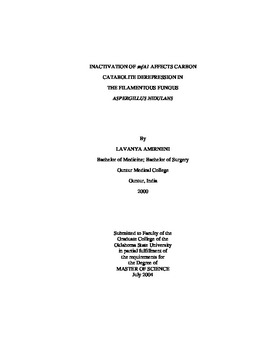| dc.contributor.advisor | Prade, Rolf A. | |
| dc.contributor.author | Amirneni, Lavanya | |
| dc.date.accessioned | 2014-04-15T18:37:58Z | |
| dc.date.available | 2014-04-15T18:37:58Z | |
| dc.date.issued | 2004-07-01 | |
| dc.identifier.uri | https://hdl.handle.net/11244/8525 | |
| dc.description.abstract | Glucose, the simplest and most abundant sugar in nature, is the preferred carbon source for many organisms. In the presence of glucose, genes that are essential to metabolize alternative carbon sources are repressed, a phenomenon known as carbon catabolite repression. In yeast, the Snf1p has been shown to play a central role in carbon catabolite repression and causes derepression of the genes involved in alternate carbon source utilization, by phosphorylating Mig1p. During this work, a SNF1 homolog, snfA1, has been cloned and characterized in the filamentous fungus Aspergillus nidulans. A snfA1 deletion strain has been constructed and its phenotypic characteristics studied. The mutant grew poorly on complex carbon sources like pectin, xylan, cellulose and galacturonic acid, suggesting the role of snfA1 in polysaccharide degradation. Allyl alcohol sensitivity test showed that snfA1 strain was super resistant compared to the reference strain indicating that snfA1 interacts with creA (global transcriptional repressor) during glucose derepression mechanism. snfA1 strain also had differential expression of several genes encoding cell wall degrading enzymes, in comparison to the reference strain as evidenced by Northern blot analysis. Absence of pectinase enzyme activity in culture filtrates of snfA1 strain grown on pectin, further supports our hypothesis that snfA1 is involved in the regulation of the genes encoding cell-wall degrading enzymes. Further, in order to discover the other genes being regulated by snfA1 apart from glucose-repressed genes, microarray technology has been used to compare the expression profiles of snfA1 and wild type strains grown on glucose and pectin. Our data shows that snfA1 also regulates genes involved in other cellular processes like lipid synthesis, sterol metabolism, polysaccharide metabolism, stress and transcriptional and translational regulation. Taken together, these data suggest that snfA1 of Aspergillus nidulans is involved in carbon catabolite derepression and its deletion prevents the fungus from properly metabolizing the alternate carbon sources in the absence of glucose. | |
| dc.format | application/pdf | |
| dc.language | en_US | |
| dc.publisher | Oklahoma State University | |
| dc.rights | Copyright is held by the author who has granted the Oklahoma State University Library the non-exclusive right to share this material in its institutional repository. Contact Digital Library Services at lib-dls@okstate.edu or 405-744-9161 for the permission policy on the use, reproduction or distribution of this material. | |
| dc.title | Inactivation of Snfa1 Affects Carbon Catabolite Derepression in The Filamentous Fungus Aspergillus Nidulans | |
| dc.type | text | |
| dc.contributor.committeeMember | Hadwiger, Jeffrey | |
| dc.contributor.committeeMember | Melcher, Ulrich | |
| osu.filename | Amirneni_okstate_0664M_1067.pdf | |
| osu.college | Agricultural Sciences and Natural Resources | |
| osu.accesstype | Open Access | |
| dc.description.department | Department of Biochemistry and Molecular Biology | |
| dc.type.genre | Thesis | |
| dc.subject.keywords | snfa1 | |
| dc.subject.keywords | carbon catabolite repression | |
| dc.subject.keywords | crea | |
| dc.subject.keywords | microarrays | |
| dc.subject.keywords | allyl alcohol | |
| dc.subject.keywords | glucose repression | |
